|
|
Creator | Title | Description | Subject | Date |
| 76 |
 |
Kestle, John R. W.; MacDonald, Joel D.; Couldwell, William T. | Efficacy of multiple intraarterial papaverine infusions for improvement in cerebral circulation time in patients with recurrent cerebral vasospasm | Object. Cerebral vasospasm that is caused by aneurysmal subarachnoid hemorrhage and that is refractory to maximal medical management can be treated with selective intraarterial papaverine infusions. The effects of single papaverine treatments on cerebral circulation time are well known. The purpose ... | Cerebral vasospasm; Intraarterial papaverine infusions | 2004 |
| 77 |
 |
Schmidt, Meic H. | Embolization of sacral tumors | The management of sacral tumors is challenging because of difficulties in accessing the lesion, the high rate of local recurrence, extensive vascularity causing significant intraoperative blood loss, resistance to radiation therapy, and risk of malignant transformation. Although surgery is the main ... | Sacral tumor | 2003 |
| 78 |
 |
Dailey, Andrew T. | Emergent aneurysm clipping without angiography in the moribund patient with intracerebral hemorrhage: the use of infusion computed tomography scans | THE AUTHORS REPORT their experience with 25 patients (mean age, 44.3 ± 12.1 years) with an intracerebral hematoma (ICH) from a ruptured aneurysm who were emergently operated on without angiography. Instead, preoperative high-resolution infusion computed tomography (CT) scans were used to identify... | Ruptured aneurysms; Computed tomography; Infusion computed tomography; Aneurysm clipping | 1993 |
| 79 |
 |
Couldwell, William T.; Orlandi, Richard R.; Jensen, Randy L. | Endoscopic-assisted craniofacial resection of esthesioneuroblastoma: minimizing facial incisions | The surgical management of esthesioneuroblastomas has traditionally been craniofacial resection, which combines a bifrontal craniotomy with a transfacial approach. The latter usually involves a disfiguring facial incision, mid-facial degloving, lateral rhinotomy, and/or extensive facial osteotomies... | Esthesioneuroblastoma; Craniofacial resection; Endoscope; Craniofacial surgery; Minimally invasive | 2003 |
| 80 |
 |
Couldwell, William T. | Enhanced protein kinase C activity correlates with the growth rate of malignant gliomas in vitro | Direct measurement of protein kinase C (PKC) activity in vitro revealed a significant increase in the activity of the enzyme in all human malignant glioma lines examined and the rat C6 tumor in comparison with control nonneoplastic astrocyte and mixed glial cultures. The total and particulate PKC ac... | Brain neoplasms; Flow cytometry; Glioma; Phorbol ester; Protein kinase C | 1991 |
| 81 |
 |
Kestle, John R. W.; Brockmeyer, Douglas Lee | Evaluation of the necessity of postoperative imaging after craniosynostosis surgery | Object. Childhood radiation exposure increases the lifetime risk of cancer from an estimated 0.07 to 0.35%. Neurological evaluation of patients after cranial vault reconstruction for synostosis repair is often complicated by pain medication, sedation, intubation, swelling, and dressings; therefore c... | Computed tomography; Cranial vault reconstruction; Pediatric neurosurgery; Radiation dose; Postoperative imaging | 2007 |
| 82 |
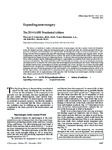 |
Couldwell, William T. | Expanding neurosurgery | The history of medicine is replete with innovations in neurosurgery that have spurred further developments across the medical spectrum. Surgeons treating pathologies in the head and spine have broken ground with new approaches, techniques, and technologies since ancient times. Neurosurgeons occupy a... | | 2014-01-01 |
| 83 |
 |
Couldwell, William T. | Experience with use of extended length peritoneal shunt catheters | The placement of a ventriculoperitoneal (VP) shunt is the current treatment of choice for diversion of cerebrospinal fluid associated with hydrocephalus. Although there are a host of reported potential abdominal complications related to the procedure, they are notably uncommon. The authors report t... | | 1996 |
| 84 |
 |
Couldwell, William T.; Chin, Steven S. | Extranodal NK/T-cell lymphoma presenting as a pituitary mass | Extranodal NK/T-cell lymphomas are uncommon neoplasms that are highly aggressive and show a strong association with Epstein-Barr virus. They most commonly affect the nasal cavity and paranasal sinuses; manifestation as a primary pituitary tumor has never been described. The authors report a case of ... | | 2007-09 |
| 85 |
 |
Couldwell, William T. | False-negative magnetic resonance angiography with extracranial internal carotid artery stenosis: a report of two cases and review of the literature | Magnetic resonance angiography (MRA) is increasingly used as a noninvasive means to assess internal carotid artery (ICA) stenosis. When used alone, however, MRA may not be sufficiently accurate in certain settings to determine whether ICA disease meets surgical criteria. Although MRA has been recogn... | Internal carotid artery stenosis; Magnetic resonance angiography | 2005 |
| 86 |
 |
Couldwell, William T. | Far Lateral Transcondylar Approach for Resection of Neurenteric Cysts of the Cervicomedullary Junction (Far-lateral transcondylar approach: surgical technique and its application in neurenteric cysts of the cervicomedullary junction. Report of two cases.) | Neurenteric cysts are rare benign lesions of the central nervous system that are lined by endodermal cell-derived epithelium. Although they occur mostly in the spine, they can occur intracranially, most often in the posterior fossa. Neurenteric cysts that are located in the anterior cervicomedullary... | Cervical Vertebrae; Medulla Oblongata; Neural Tube Defects; Neurosurgical Procedure | 2005-08-15 |
| 87 |
 |
Schmidt, Meic H.; Couldwell, William T. | Far lateral transcondylar transtubercular approach to lesions of the ventral foramen magnum and craniovertebral junction | The craniovertebral junction, which consists of the lower one third of the clivus, the foramen magnum, and the CI and C2 vertebrae, is a common site for neoplastic, vascular, congenital, and degenerative lesions of the cranial base. The far lateral transcondylar transtubercular approach (commonlyr... | Far-lateral; Transcondylar; Transtubercular; Ventral foramen magnum; Craniovertebral junction | 2007 |
| 88 |
 |
Couldwell, William T. | Far-lateral transcondylar approach: surgical technique and its application in neurenteric cysts of the cervicomedullary junction | Neurenteric cysts are rare benign lesions of the central nervous system that are lined by endodermal cell-derived epithelium. Although they occur mostly in the spine, they can occur intracranially, most often in the posterior fossa. Neurenteric cysts that are located in the anterior cervicomedullary... | | 2005 |
| 89 |
 |
Couldwell, William T. | Fenestration of the oculomotor nerve by a duplicated posterior cerebral artery and aneurysm | The authors report a case of a posterior cerebral artery aneurysm arising from an aberrant arterial branch that was found to be splitting the oculomotor nerve. This 63-year-old man presented with headaches, and CT imaging revealed subarachnoid hemorrhage primarily within the basilar cisterns. Formal... | | 2009-01-01 |
| 90 |
 |
Schmidt, Meic H. | Frameless stereotactic image-guided C1-C2 transarticular screw fixation for atlantoaxial instability: review of 20 patients | Atlantoaxial instability can result from trauma, rheumatoid arthritis, congenital malformation, or tumor invasion. The goal of treatment is stabilization of the C1-C2 complex to prevent neurologic and neurovascular compromise. First described in 1987 by Magerl and Seemann, C1-C2 transarticular screw... | Transarticular screws; Atlantoaxial instability; Frameless stereotaxy; Cervical spine; Surgical navigation; Trajectory planning | 2005 |
| 91 |
 |
Couldwell, William T. | The frontotemporal (Pterional) approach: an historical perspective | The frontotemporal, so-called "pterional" approach has evolved with the contribution of many neurosurgeons over the past century. It has stood the test of time and been the most commonly used transcranial approach in neurosurgery. In its current form, drilling the sphenoid wing as far down as the su... | | 2012-01-01 |
| 92 |
 |
Couldwell, William T. | Ganglion cyst of the temporomandibular joint with intracranial extension in a patient presenting with seventh cranial nerve palsy | Ganglion cysts arising from the temporomandibular joint are rare entities that often present with swelling and minimal to no pain in the preauricular region. To the Author's? knowledge, a temporomandibular joint ganglion cyst occurring with acute facial nerve palsy and intracranial extension has ne... | | 2012 |
| 93 |
 |
Couldwell, William T. | Giant fusiform aneurysm in an adolescent with PHACES syndrome treated with a high-flow external carotid artery-M3 bypass | The acronym PHACES describes a rare neurocutaneous syndrome that comprises posterior fossa malformations, facial hemangiomas, arterial anomalies, coarctation of the aorta and cardiac defects, eye abnormalities, and sternal defects. Facial hemangiomas constitute the hallmark of this disorder. Giant ... | | 2007 |
| 94 |
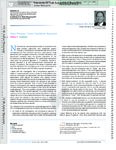 |
Couldwell, William T. | Giant pituitary tumor combined approach | Nishioka et al. have provided a review of 29 patients with large pituitary adenomas who underwent surgery through a simultaneous transsphenoidal and transcranial approach at their institution during a 7-year period. Large adenomas with hourglass constriction, complex lobulations, and asymmetric exte... | | 2012-01-01 |
| 95 |
 |
Couldwell, William T.; Schmidt, Richard H.; Salzman, Karen L.; Chin, Steven S. | Glioblastoma multiforme of the pineal region | Glioblastoma multiforme (GBMs) tumors are exceedingly rare tumors in the pineal region. We present three cases in which patients presented with a pineal/posterior third ventricular region mass and review all the previously reported cases in the literature. Pineal region GBM seems to be a very aggre... | Glioblastoma multiforme; Hydrocephalus; Leptomeningeal dissemination; Malignant glioma; Perinaud's syndrome; Pineal region; Spinal metastases | 2006 |
| 96 |
 |
Couldwell, William T. | Glioma invasion | A characteristic pathological feature of malignant glioma cells is their ability to extensively invade surrounding brain parenchyma-particularly along white matter tracts- thus rendering focal therapies incapable of controlling tumor growth and resulting in inevitable recurrence. In this regard, ... | | 2001 |
| 97 |
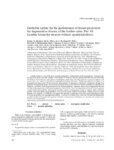 |
Dailey, Andrew T. | Guideline update for the performance of fusion procedures for degenerative disease of the lumbar spine. Part 10: Lumbar fusion for stenosis without spondylolisthesis | Lumbar stenosis is one of the more common radiographic manifestations of the aging process, leading to narrowing of the spinal canal and foramen. When stenosis is clinically relevant, patients often describe activity-related low-back or lower-extremity pain, known as neurogenic claudication. For tho... | | 2014-01-01 |
| 98 |
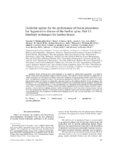 |
Dailey, Andrew T. | Guideline update for the performance of fusion procedures for degenerative disease of the lumbar spine. Part 11: Interbody techniques for lumbar fusion | Interbody fusion techniques have been promoted as an adjunct to lumbar fusion procedures in an effort to enhance fusion rates and potentially improve clinical outcome. The medical evidence continues to suggest that interbody techniques are associated with higher fusion rates compared with posterolat... | | 2014-01-01 |
| 99 |
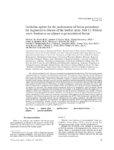 |
Dailey, Andrew T. | Guideline update for the performance of fusion procedures for degenerative disease of the lumbar spine. Part 12: Pedicle screw fixation as an adjunct to posterolateral fusion | The utilization of pedicle screw fixation as an adjunct to posterolateral lumbar fusion (PLF) has become routine, but demonstration of a definitive benefit remains problematic. The medical evidence indicates that the addition of pedicle screw fixation to PLF increases fusion rates when assessed with... | | 2014-01-01 |
| 100 |
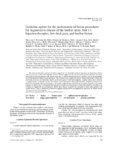 |
Dailey, Andrew T. | Guideline update for the performance of fusion procedures for degenerative disease of the lumbar spine. Part 13: Injection therapies, low-back pain, and lumbar fusion | The medical literature continues to fail to support the use of lumbar epidural injections for long-term relief of chronic back pain without radiculopathy. There is limited support for the use of lumbar epidural injections for short-term relief in selected patients with chronic back pain. Lumbar intr... | | 2014-01-01 |

























